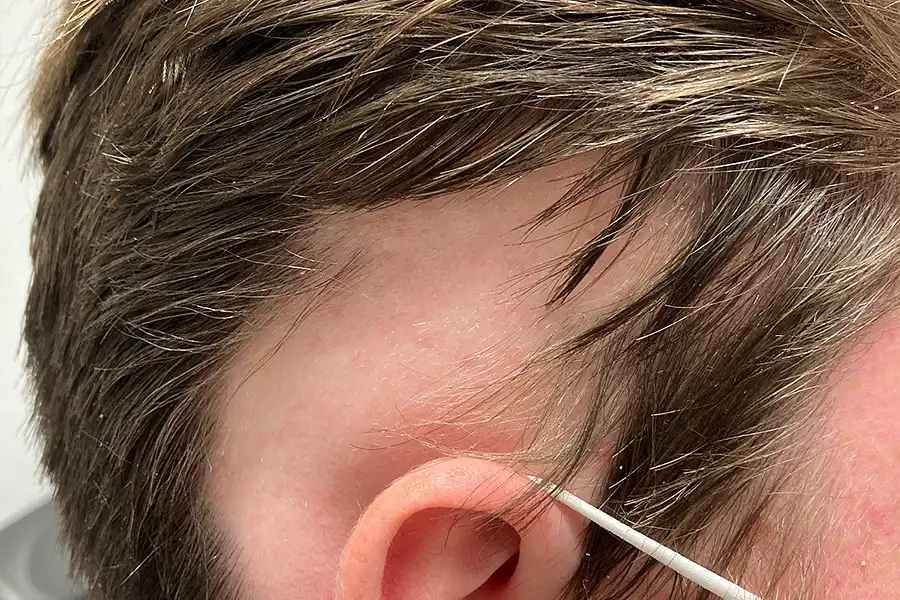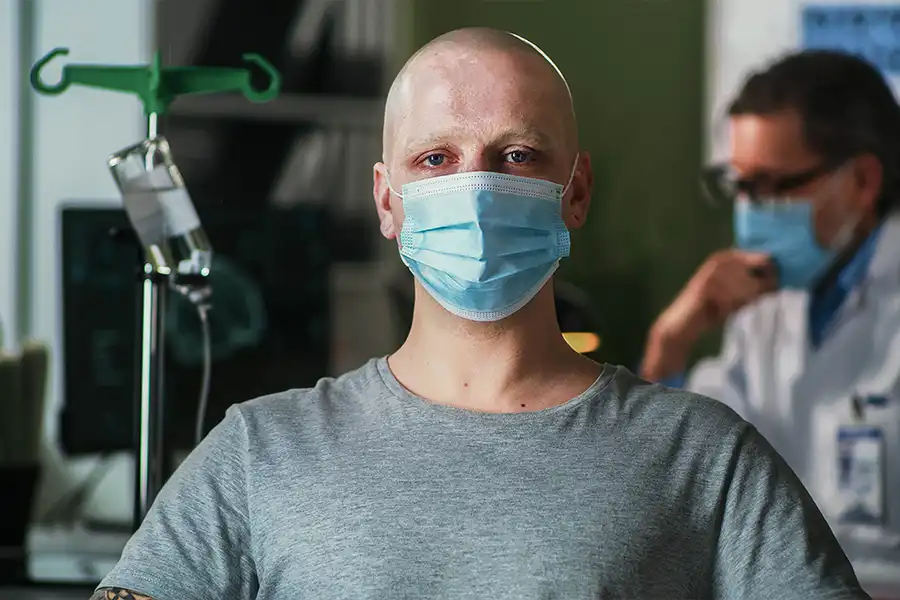Causes of Hair Loss
Male Pattern Baldness (Androgenic Alopecia)
Diffuse hair loss through the vertex (top) of the scalp is a symptom of Male Pattern Hair Loss (MPHL). With MPHL you may begin to notice thinning throughout the top of your scalp, without affecting the hair around your sides and back. A genetic predisposition associated with sensitivity to androgens (male hormones) is the cause of MPHL.
Men over 30 are more likely to have MPHL, however some men may not thin until they are 50 or older. You can get a diagnosis from our in-clinic trichologist to find out if you have MPHL. The Norwood-Hamilton scale will be utilized to assess the degree of hair loss and provide recommendations regarding the most suitable treatment plan.

What Are My Options If I Have Male Pattern Baldness?
Hair thickening spray is an effective way to give the appearance of fuller hair by concealing thinner areas. You can read more about this on the concealment page under ‘our solutions’.
Alternatively, our pre-designed hair systems provide maximum coverage and can be completely personalized by our team to fit your specific measurements, style, and colour requirements.
Top-pieces can be used with your natural hair in two ways: as a semi-permanent attachment that allows you to remove and re-apply the system whenever you desire, or a more “permanent” attachment that can last up to four weeks. Adhesive is a method that uses soft glue applied directly to the scalp, whereas Micropoint uses your natural hair to bond with the system. Top pieces restore volume and density that may have been lost while providing a very natural finish.
Alopecia
Alopecia is the umbrella term for many types of hair loss. Areata, Totalis, and Universalis alopecia are the most prevalent types.
While Androgenic Alopecia (Male/Female Pattern Hair Loss) is a genetically predisposed condition, Alopecia Areata, Totalis, and Universalis are autoimmune disorders. When you have an autoimmune disease, your immune system attacks your hair follicles because it believes they are foreign objects. This leads to hair loss.
Alopecia Areata: This condition manifests as tiny, circular patches of partial hair loss. These may spread over time and roam, or shift from one part of the scalp to another. But without treatment, there’s a chance the hair will grow back on its own.
Alopecia Totalis: This form of alopecia causes complete loss of hair on the scalp. It can also affect to the lashes and eyebrows, but this is the extent of the condition.
Alopecia Universalis: This type of alopecia results in complete body hair loss. It might start out as a different kind of alopecia and progress with time.
Although the exact cause of alopecia is unknown, stress and other traumas have been connected in the past.

If I Have Alopecia, What Are My Options?
Getting a diagnosis is the first step in finding a solution for your hair loss. Our in-clinic trichologist can diagnose and provide prognostic information for all types of alopecia. Following this, you could schedule a FREE consultation to get advice on our concealment products and hair systems from one of our consultants.
Our hair thickening spray can be used to give the appearance of full hair coverage if small round circles did start to appear, but they aren’t changing your hairstyle and you’re just looking for coverage. The pigmented spray is applied directly onto the scalp to conceal any spots of hair loss.Using micro-mineral particles, the spray will bond to existing hair around the areas of hair loss, and sit on the scalp, sealed in with a seal and control spray – changing the way you look and feel within seconds! The spray comes in a variety of shades that can be mixed to create the best colour to match your own hair. If you’re not quite ready to purchase a hair system, or if the area you are experiencing hair loss is still actively growing or moving, this spray is an excellent substitute. It’s also very easy to use. Our hair thickening and control sprays are available for purchase from reception.
Chemotherapy
Since chemotherapy causes hair loss in any hair currently in the Anagen (growth) phase of the hair cycle, it is scientifically referred to as “Anagen Effluvium.”
In general, 14 to 21 days following their first session is when patients start to notice hair loss. Contrary to popular belief, hair loss resulting from chemotherapy does not occur from the root. Instead, in reaction to the toxins in the chemotherapy, the hair breaks off and “falls out” at the scalp level. This means that the hair bulb is still within the hair follicle. Since the hair bulb remained intact throughout the chemotherapy, the hair will start to grow again right away!

When Should I Start To Look For My Hair Replacement Solution?
For patients whose chemotherapy is scheduled to start on a certain date, we recommend making an appointment with us one or two weeks in advance. This helps us determine your needs as precisely as possible, especially if you want a hair system that looks like your current hair. It also ensures that the system is ready for you when the time comes.
When My Hair Regrows, What Do I Do?
Your hair will start to grow back after the end of your treatment, but sometimes patients notice a subtle change in the curl or texture of their hair. When your hair does start to grow back, there are ways to support strong, healthy hair and Advanced Appearance is here to help you with every step of the recovery process. You can get regular trims here, which will help keep your hair strong and remove split ends. We also provide a selection of La Biosthetique’s nourishing and scalp-friendly medicated shampoos and conditioners.
Trichotillomania (Hair Pulling)
A rare impulse control disorder called trichotillomania causes a person to obsessively pull out hair from their scalp, lashes, eyebrows, or pubic region. Some people will remove individual hairs from the root, while others might remove large handfuls at once.
Trichotillomania often develops in childhood and may go away as a child grows older. Nonetheless, if an adult has experienced the illness as a child, it is typical for the condition to resurface in adulthood.
Although the exact causes of trichotillomania are unknown, there is evidence that the disorder may be triggered by stress and other traumas. Some people may hide their condition as a result of this behaviour, rather than asking for assistance or support. In severe situations, ingesting the removed hair may result in internal obstruction.

What Do I Do If I Have Trichotillomania?
In the event that I have trichotillomania, what are my options?
It’s essential to get the right support if you believe you or someone you know suffers from trichotillomania. Our trichologist can provide you with information on the diagnosis and prognosis of trichotillomania if you’re looking for a clinical diagnosis. You will be advised on the best course of action and most appropriate coverage option.
Our hair thickening spray, which comes in a variety of colours to match your natural hair, can be used in small areas to create the appearance of full hair coverage. A partial or full head system may be an option if the hair loss is extensive or interferes with your hairstyle. We have a wide range of hair system types in stock. A hair system may occasionally be affixed to the afflicted area to stop recurrent pulling, since some patients find that their urge to pull lessens when they are unable to access the area from which they typically pull.
Other Causes
There could be a simple explanation for why you might be losing hair. Please click here to view additional conditions that we observe at Advanced Appearance.
Free Consultation
At Advanced Appearance we offer FREE one-to-one hair loss consultations. Our discretion extends far beyond our clinic frontage; as we have 7 private consultation rooms and an elite team with years of first-hand understanding and experience, to ensure you feel comfortable and at ease when you visit us.
